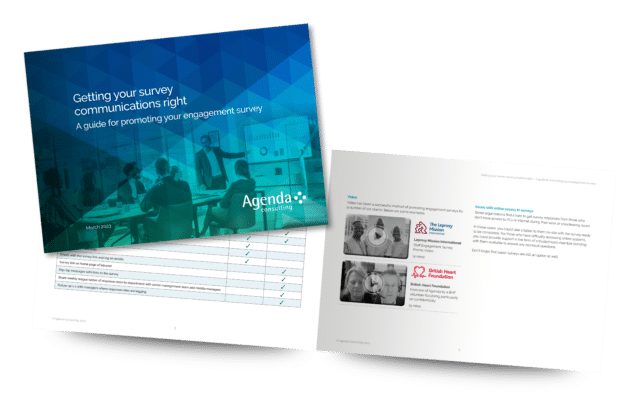
Insights
Helping not-for-profit organisations develop and sustain
the highest levels of employee and volunteer engagement

Insights
The effectiveness of employee and volunteer surveys depends largely on the honesty and transparency of the responses they collect.
A common response option that often presents challenges for organisations is “Prefer not to say” – particularly in response to personal demographic questions such as ethnicity or sexual orientation.
This option is a legal requirement designed to enable individuals to keep certain information private. It helps to ensure respondents feel comfortable and respected when answering sensitive questions.
Out of over 5400 UK charity employees surveyed, 11% chose the “Prefer not to say” option for questions on gender, sexual orientation, and religion.
However, there was considerable variation between organisations, with the percentage ranging from as low as 6% to as high as 19%. This variation suggests that organisations can influence these scores.
This chart shows the average across the sample of organisations that selected ‘Prefer not to say’.
If your results are particularly negative for the “Prefer not to say” group, or you receive a higher-than-average number of “Prefer not to say” responses, it can be difficult to draw meaningful conclusions from the data. Therefore, you’ll want to do everything you can to reduce the number of “Prefer not to say” responses in your survey results.

Some employees are hesitant to share personal information due to concerns about privacy and the confidentiality of their responses. They may worry that their data could be traced back to them, especially if they intend to provide negative feedback about the organisation, leading to fears of retaliation.
Employees may worry that revealing certain aspects of their identity, such as their religion, or sexual orientation, could expose them to discrimination or bias.
If employees lack trust in their organisation’s commitment to addressing issues like diversity and inclusion, they might be less inclined to share personal details. This can be particularly true if there is a history of negative experiences or if past survey feedback has been ignored.
Without a clear understanding of why certain personal questions are being asked and how the information will be used, employees may choose the “Prefer not to say” option for demographic questions as a precautionary measure.
 Incomplete Data
Incomplete DataWhen employees choose “Prefer not to say,” it can result in incomplete data, making it difficult to gain an accurate understanding of the workforce’s demographics and different groups’ unique experiences within the organisation.
A higher percentage of “Prefer not to say” responses might indicate underlying issues, such as a lack of trust or fear of retaliation.
In our experience, when analysing client survey results, the “prefer not to say” group tends to express more negative sentiments across various topics.
To reduce the number of “Prefer not to say” responses and improve the quality of your survey data, consider implementing the following strategies:
Clearly communicate the measures in place to protect the confidentiality of survey responses. Assure employees that their data will be kept private. Consider using third-party survey platforms to enhance anonymity and reassure employees of impartial handling of their responses.
For example, when reporting on our clients’ surveys, we implement a minimum response number to ensure no individual respondent’s data can be singled out, safeguarding confidentiality. This practice helps build trust and encourages more open and honest participation in surveys
Clearly explain to your people why demographic questions are being asked and how this information will be used.
Communicate how these questions provide valuable insights into the diversity of the workforce helps organisations identify and address any gaps in inclusion and equity.
It can help to highlight how previous survey results have led to positive changes, building trust and encouraging more open and honest responses. For more guidance, download our free survey communications guide.
 Address “Prefer Not to Say” Responses in Reports
Address “Prefer Not to Say” Responses in ReportsWhen analysing survey data, it’s important to recognise that “Prefer not to say” responses may have lower overall scores compared to other demographics. To address this, consider the following:
While these responses shouldn’t be the focus of survey reporting, if there is a significant number, it may be worth investigating the reasons behind them.
Efforts should be made to reduce ‘prefer not to say’ answers by fostering good communications, providing reassurances of confidentiality, and building a culture of trust.
Want to speak to an expert about your organisation’s survey strategy? Get in touch
Author
Georgia-Lee Slater, Research Consultant
5 Linford Forum
Rockingham Drive
Milton Keynes
MK14 6LY
UK
Company No: 4509427
